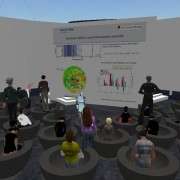Scientists demonstrate their commitment to the environment by going 'virtual'

Scientists from around the world proved their green credentials by participating in a conference on climate change and carbon dioxide storage in the virtual world, this week (3 December).
Organised by Imperial College London and Nature Publishing Group, the conference encouraged scientists to meet in the virtual environment of Second Life, instead of the real world, to reduce carbon dioxide emissions normally associated with travelling long distances to international events.
Second Life is a 3-D virtual world populated by people who operate computer characters, or avatars. These can interact with millions of other avatars to participate in a range of activities online. In this world, Nature Publishing Group has created a virtual island and virtual buildings to hold meetings in.
Dr Tara LaForce, from Imperial’s Department of Earth Science and Engineering, has already held a lecture on carbon capture and storage on Nature’s virtual Elucian Islands. She decided to organise the Virtual Climate Change conference in the same place to demonstrate the environmental benefits of meeting online. Dr LaForce says:
“On average, scientists travelling to international conferences generate at least 1.5 tonnes of carbon dioxide per trip. This is roughly the same amount of carbon dioxide produced by the average commuter in London for an entire year. We scientists could contribute more to reducing our carbon footprint by making at least one of our yearly conferences virtual. Second Life provides a great opportunity for us to experiment with this idea.”
The Virtual Climate Change conference broadly covered all aspects of climate change and carbon dioxide storage, from the future effects of extreme climate change on the planet such as hot and dry spells, to new technologies and advances in capturing and storing carbon dioxide deep underground.
The conference was broadcast live from Second Life via video screens into lecture theatres including Stanford University, University of Wyoming, University of Southern California and the University of Texas, Austin, and at Imperial’s Grantham Institute for Climate Change. Attendees were able to ask questions via a representative avatar.
Professor Martin Blunt, Head of the Department of Earth Science and Engineering, was one of the key speakers at the conference.
Through his Second Life avatar, Boffy Destiny, Professor Blunt delivered his virtual lecture on methods for capturing carbon dioxide from UK power stations and injecting it into depleted North Sea oil reservoirs or salt water aquifers. He says his experience online showed him how civilised virtual conferences could be. He adds:
“Since the days of Socrates people have understood the importance of meeting face-to-face. However, I think we’ll see more academics and students meeting in virtual spaces in the future because it wipes out travel costs, lessens our environmental impact, and reduces the hassle of travelling, especially for non-European academics and students whose travel can often be frustrated by visa restrictions.”
Professor Sir Brian Hoskins, Director of the Grantham Institute for Climate Change, gave a talk on climate science, and says his first experience of delivering a virtual lecture was very positive as it enabled him to reach an international audience with great ease. However, he did say that there were some drawbacks.
“I like to gesticulate when I am communicating and I obviously couldn’t convey that through my avatar. So I had to remember to get my message across to the virtual audience verbally,” says Sir Brian Hoskins.
He added that he could see the potential benefits that this technology could bring in the future.
“Part of the ‘oomph’ from a real lecture comes from being able to see and interact with your audience. As this technology evolves so that characters can sense each other’s gestures and movements, I can see this being an even more important tool for exchanging information between people,” says Sir Brian Hoskins.
Other speakers at the one day conference included Professor Franklin M Orr, Jr., Director of the Global Climate and Energy Project at Stanford University. He spoke about the use of various technologies to mitigate the effects of climate change.
Since its inception in 2003, Imperial has been keen to exploit Second Life as a learning and communication tool. The Department of Biosurgery and Surgical Technology was one of the first at Imperial to hold a virtual conference, and scientists such as Dr James Kirkpatrick, from the Department of Physics, and Dr Simon Colton, from the Department of Computing, have also given virtual lectures.
Lord Ara Darzi, Professor of Surgery at Imperial, also worked with the UK’s National Physical Laboratory (NPL) to create a virtual hospital in Second Life. Called ‘Second Health’, the initiative has been devised to show Londoners how they might experience hospital care in the future.
Provided by Imperial College London





















